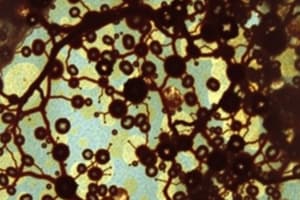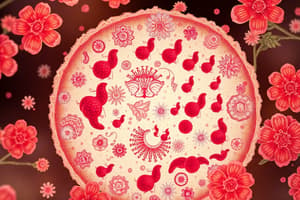Podcast
Questions and Answers
Quel type de cytologie est utilisé pour évaluer des masses palpables?
Quel type de cytologie est utilisé pour évaluer des masses palpables?
- Cytologie des fluides corporels
- Aspirat à l'aiguille fine (FNA) (correct)
- Cytologie exfoliative
- Cytologie des crachats
La cytologie est toujours suffisante pour détecter tous les cancers invasifs.
La cytologie est toujours suffisante pour détecter tous les cancers invasifs.
False (B)
Quelles informations peuvent être obtenues grâce à l'analyse cytologique des fluides corporels?
Quelles informations peuvent être obtenues grâce à l'analyse cytologique des fluides corporels?
Diagnostic de diverses conditions
La cytologie ______ aide à détecter les anomalies cellulaires précoces.
La cytologie ______ aide à détecter les anomalies cellulaires précoces.
Associez les types de cytologie avec leur utilisation principale :
Associez les types de cytologie avec leur utilisation principale :
Quelle technique est essentielle pour améliorer le contraste et la visualisation des structures cellulaires sous le microscope ?
Quelle technique est essentielle pour améliorer le contraste et la visualisation des structures cellulaires sous le microscope ?
Le noyau de la cellule est responsable de la production d'énergie.
Le noyau de la cellule est responsable de la production d'énergie.
Quel est le rôle principal de la cytologie dans le domaine médical ?
Quel est le rôle principal de la cytologie dans le domaine médical ?
La ____ est la frontière extérieure de la cellule, régulant le passage des substances.
La ____ est la frontière extérieure de la cellule, régulant le passage des substances.
Quel type de microscopie est utilisé pour obtenir une très haute résolution ?
Quel type de microscopie est utilisé pour obtenir une très haute résolution ?
Associez chaque organite avec sa fonction principale :
Associez chaque organite avec sa fonction principale :
La cytologie ne peut être utilisée que pour le dépistage du cancer.
La cytologie ne peut être utilisée que pour le dépistage du cancer.
Quel est un exemple courant de technique de coloration utilisée en cytologie ?
Quel est un exemple courant de technique de coloration utilisée en cytologie ?
Flashcards
Biopsie tissulaire
Biopsie tissulaire
L'examen des cellules prélevées sur un tissu pour diagnostiquer des maladies.
Cytologie
Cytologie
L'étude des cellules, incluant leur structure, fonction et pathologie.
Morphologie cellulaire
Morphologie cellulaire
L'étude de la forme et de la structure des cellules.
Aspirations à l'aiguille fine (AAF)
Aspirations à l'aiguille fine (AAF)
Signup and view all the flashcards
Cytologie exfoliative
Cytologie exfoliative
Signup and view all the flashcards
Microscopie
Microscopie
Signup and view all the flashcards
Impressions cytologiques
Impressions cytologiques
Signup and view all the flashcards
Coloration cellulaire
Coloration cellulaire
Signup and view all the flashcards
Cytologie des liquides corporels
Cytologie des liquides corporels
Signup and view all the flashcards
Préparation des échantillons
Préparation des échantillons
Signup and view all the flashcards
Cytologie liquide
Cytologie liquide
Signup and view all the flashcards
Membrane cellulaire
Membrane cellulaire
Signup and view all the flashcards
Noyau
Noyau
Signup and view all the flashcards
Study Notes
Introduction to Cytology
- Cytology is the study of cells, encompassing their structure, function, and pathology.
- It involves examining cells from various bodily fluids and tissues.
- Cell morphology, the study of cell form, is crucial for identifying and categorizing cells.
- Cytology plays a vital role in diagnosing and monitoring illnesses, particularly in cancer detection and management.
Techniques in Cytology
- Microscopy: A fundamental technique for visualizing cells and their components.
- Different microscopy types (light, electron) are used based on the desired level of resolution.
- Microscopic examination allows assessment of cell size, shape, and internal structures like the nucleus.
- Cell Staining: Essential for highlighting cellular structures, improving contrast, and facilitating visualization under the microscope.
- Various stains target specific components (e.g., nuclei, cytoplasm).
- Hematoxylin and eosin (H&E) staining is a common technique.
- Preparation of Samples: Crucial for optimal cell preservation and visualization.
- Different preparation methods exist for various sample types (e.g., fine-needle aspiration, brushing).
- Proper fixation and processing steps are essential to preserve cell morphology during examination.
- Liquid-based cytology: Preserves cellular architecture and reduces the risk of artifacts.
- Cytospin, a technique for concentrating cells from a fluid sample, improves visualization and identification.
Cell Structure and Function
- Cell Membrane: The outer boundary of the cell, regulating the passage of substances in and out.
- Cytoplasm: The fluid-filled space containing organelles and cellular machinery.
- Nucleus: The control center of the cell, housing genetic material (DNA) and influencing cellular activity.
- Organelles: Specialized structures within the cytoplasm, each with specific functions (e.g., mitochondria for energy production).
- Ribosomes are essential for protein synthesis.
Clinical Applications of Cytology
- Cancer Screening and Diagnosis: Cytology is widely used in identifying atypical cells, potentially indicative of cancerous changes.
- The Pap smear for cervical cancer screening is a prime example.
- Infectious Disease Diagnosis: Identifying pathogens (bacteria, viruses) through cellular analysis.
- Monitoring Treatment Response: Cytological studies assess cancer's response to therapy and determine its progression.
- Evaluating Tissue Biopsies: Cell morphology information from biopsies aids in determining the nature of diseases.
Types of Cytological Examinations
- Fine Needle Aspiration (FNA): A technique for collecting cells from a mass or lump.
- Often used for evaluating palpable masses.
- Exfoliative Cytology: Examining cells shed from a body surface or cavity (e.g., Pap smears).
- Commonly used for identifying precancerous conditions and screening for cancer.
- Imprints: Obtaining tissue samples for cytological analysis using a direct contact imprint method.
- Obtaining tissue samples for cytological analysis directly using an imprint method.
- Sputum Cytology: Evaluating cells collected from sputum to assess lung conditions and identify potential infections or malignant processes.
- Body Fluid Cytology: Examining cells from body fluids like urine or cerebrospinal fluid to diagnose various conditions.
Importance and Limitations of Cytology
- Early Detection: Early detection of cellular abnormalities is crucial.
- Non-invasive: Many cytological procedures are minimally invasive, reducing patient discomfort.
- Cost-effective: Cytological examinations are generally cost-effective, important in healthcare budgets.
- Limitations: Cytology may not detect subtle or advanced cancers, necessitating further investigations in some instances.
- Limitations in cytological diagnosis include difficulty in identifying subtle changes, often requiring additional diagnostic methods and analyses in complex cases.
- Interdependence: Cytology often complements other diagnostic methods (e.g., histopathology, molecular diagnostics) for comprehensive assessments, enabling better diagnosis, monitoring, and prognosis.
Studying That Suits You
Use AI to generate personalized quizzes and flashcards to suit your learning preferences.




